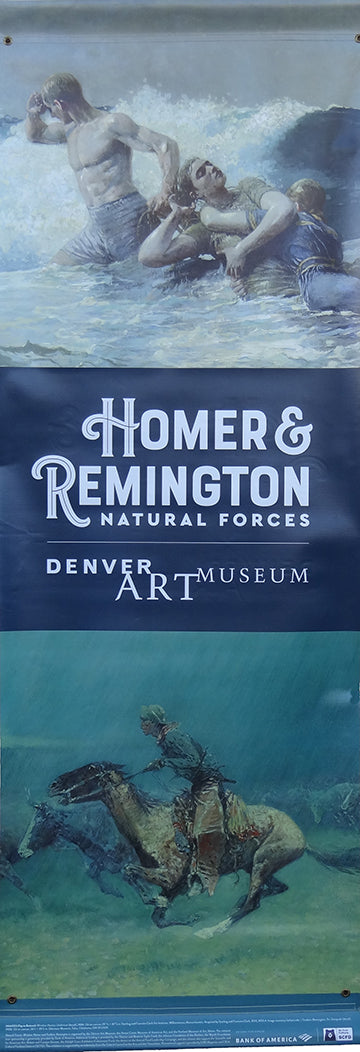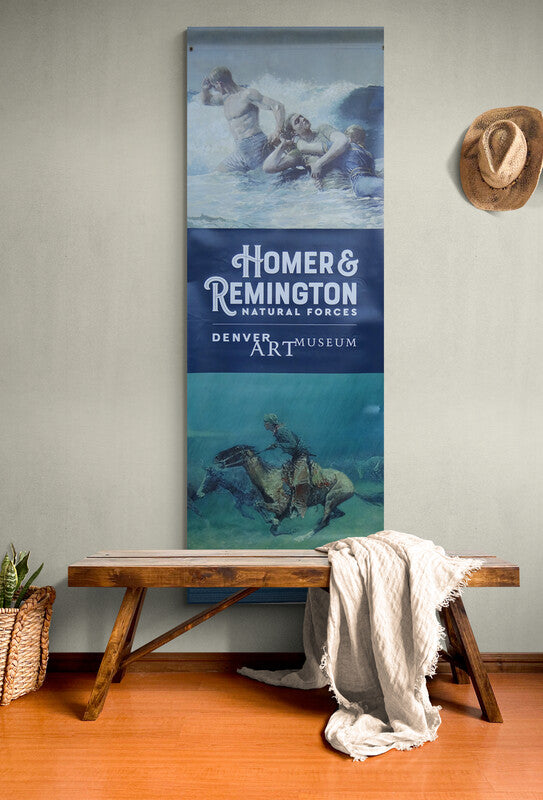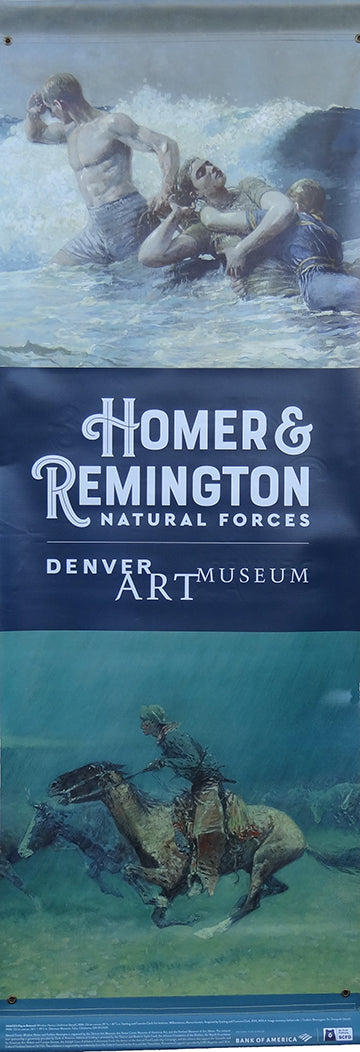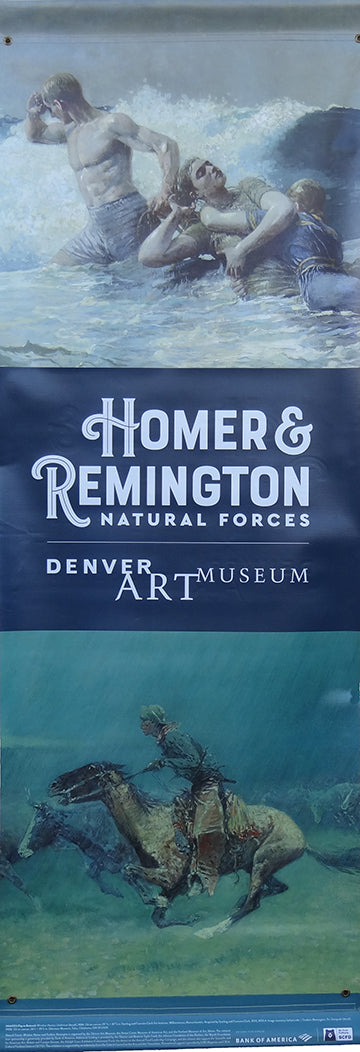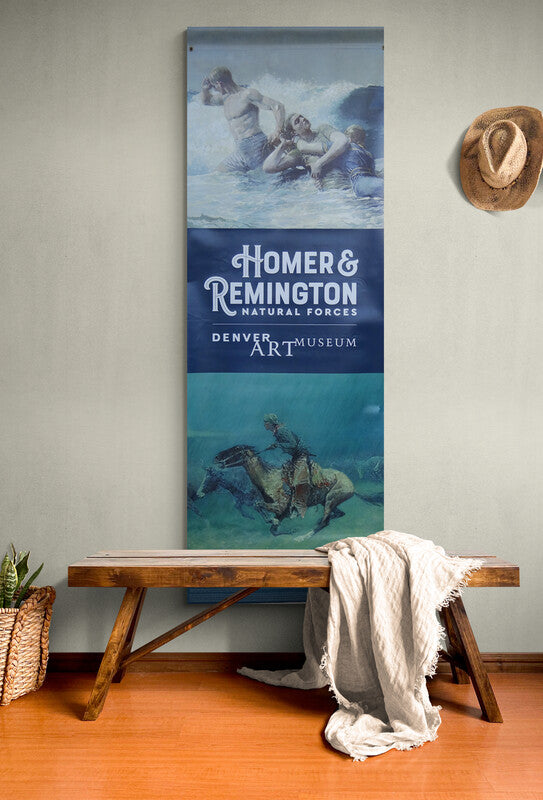Denver Art Museum
Homer and Remington "Natural Forces"
Homer and Remington "Natural Forces"
Couldn't load pickup availability
Share
From: Denver Art Museum
Limited Edition: 30
Exhibition: Natural Forces: Winslow Homer and Frederic Remington
Material: Printed Vinyl
Dimensions: 30" x 89" (76cm x 226cm)
Hanging Hardware Included
Summary
Like a number of museum shows, Natural Forces was slated to open soon after the United States became the epicenter of the COVID-19 virus in 2020. The unintentional timing of this exhibition coincided with a pandemic that forced people world wide to meaningfully alter their daily lives and grapple with circumstances brought on by the natural world. This reality lent to an ironic new significance of the show that that explored Winslow Homer and Frederic Remington’s interpretation of man’s resilience in the face of nature.
Despite the considerable accommodations necessitated by the pandemic, Natural Forces did not suffer, instead the content of the exhibition only became richer and more impactful. A testament to the timelessness and ingenuity of these artists’ works as well as their unparalleled ability to highlight man’s resilience even in the most difficult of times. The pandemic allowed for entirely new perspectives to evolve from the exhibition’s content, while offering an opportunity to pause and consider the number of seemingly insurmountable obstacles that mankind has overcome.
Description
In June of 2020, the Denver Art Museum opened its ‘Natural Forces’ exhibition, featuring sixty of the acclaimed artists’ works. Seemingly distinct American painters, both explore themes of the fragility of man against the unrelenting elements of nature from the Eastern Seaboard to the American West.
Of the two main images used to promote the exhibit, one displays the commandeering nature of the ocean, as witnessed by Winslow Homer. Regarded as one of the most unique painters of his time, Homer’s works took on an intensity that echoed the ocean depicted therein. The dramaticism of his works are demonstrated through his use of rich colors as well as the juxtaposition of the figures’ apparent strength with their evident struggle against the sea’s power. The other captures the essence of America’s New Frontier. Influenced by the works of Monet and Childe Hassam, Frederic Remington was able to capture the American West in motion through his impressionistic style. Both self-taught and homegrown, Homer and Remington were renowned American painters of the 19th century.
Both painters explored the theme of man versus nature, however, in markedly unique approaches. Winslow Homer’s Undertow is the product of the solitude that defined the later years of his life. After traveling around the East Coast and Europe, Homer finally settled in a secluded coastal town in Maine and his works adopted an intensity that had not been seen in his earlier works. During this time in Homer’s life, the themes evolved from man simply existing in nature to man’s undeniable struggle against it, namely the ocean’s unforgiving power. Exemplifying this, Undertow depicts a dramatic rescue of two women fighting the weight of their waterlogged garments. Homer’s realistic style with his use of deep hues and powerful strokes mimics the power and force of the ocean, while demonstrating its breath-taking beauty. Remaining well-known today, Homer’s works are acclaimed for their idiosyncratic ability to personify the ocean through his expert brushwork and dynamic compositions.
Frederic Remington’s works, on the other hand, represent the fear and excitement that defined the pioneers’ movement West. With lands both unknown and overrun by nature, Remington effectively paints the story of the trials and tribulations as man attempted to control the unkempt state of nature that characterized the ‘Wild West’. The Stampede was one of his last works before his death, evoking an intensity unparalleled to his earlier works. The dynamism of the work from the heavy downpour and bolt of lightning to the single rider among a herd of wild horses depicted through dark, muddled hues illustrates an undeniable urgency that immediately engages the viewer. Remington was one of the first American artists to master the portrayal of a galloping horse, cementing his position as one of the most successful western artists during his time.
The banner used to promote the exhibition features detail from Winslow Homer's Undertow on the top, showing a muscled man rescuing two women from the ocean surf. The bottom of the banner shows a horse and rider in a storm from Frederic Remington's The Stampede. The middle section reads "Homer and Remington. Natural Forces" in white with the Denver Art Museum word mark below that, all on a blue-green background. The back side of the banner is identical to the front.
Provenance
This banner was displayed at the Denver Art Museum’s Natural Forces exhibition, featuring both Winslow Homer and Frederic Remington, between June 26, 2020 and September 7, 2020.
About the Artists
Credits
Winslow Homer, Undertow (detail), 1886, Oil on canvas. The Clark Art Institute, 1955.4.
Remington, Frederic. The Stampede. 01.2329. 1908. Tulsa: Gilcrease Museum, https://collections.gilcrease.org/object/012329 (05/08/2019).
